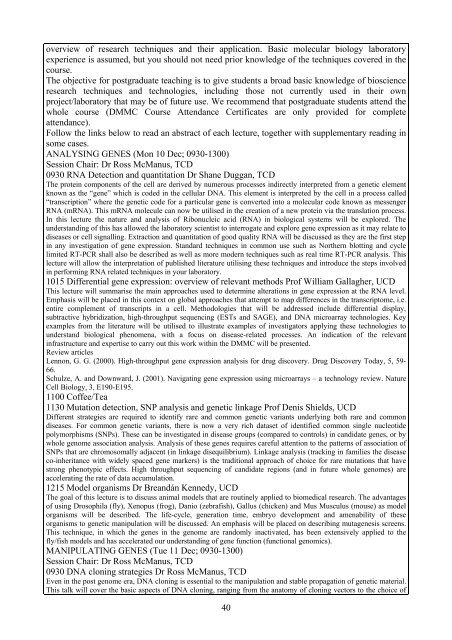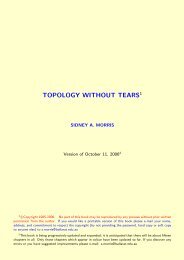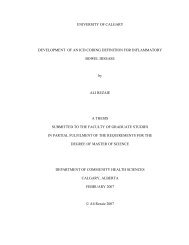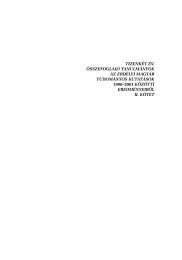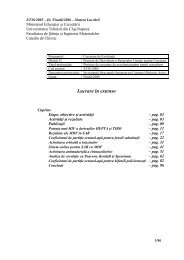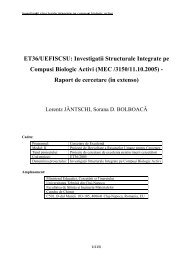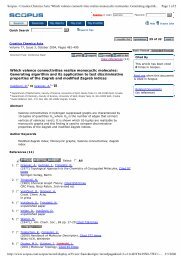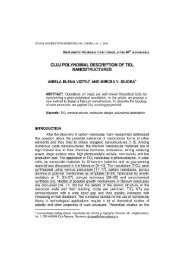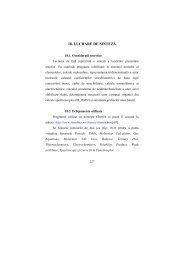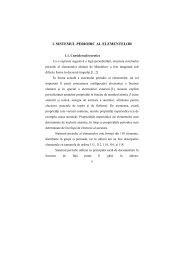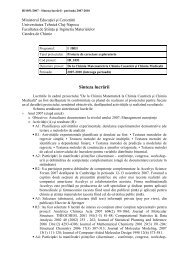Raport de cercetare - Lorentz JÄNTSCHI
Raport de cercetare - Lorentz JÄNTSCHI
Raport de cercetare - Lorentz JÄNTSCHI
You also want an ePaper? Increase the reach of your titles
YUMPU automatically turns print PDFs into web optimized ePapers that Google loves.
overview of research techniques and their application. Basic molecular biology laboratory<br />
experience is assumed, but you should not need prior knowledge of the techniques covered in the<br />
course.<br />
The objective for postgraduate teaching is to give stu<strong>de</strong>nts a broad basic knowledge of bioscience<br />
research techniques and technologies, including those not currently used in their own<br />
project/laboratory that may be of future use. We recommend that postgraduate stu<strong>de</strong>nts attend the<br />
whole course (DMMC Course Attendance Certificates are only provi<strong>de</strong>d for complete<br />
attendance).<br />
Follow the links below to read an abstract of each lecture, together with supplementary reading in<br />
some cases.<br />
ANALYSING GENES (Mon 10 Dec; 0930-1300)<br />
Session Chair: Dr Ross McManus, TCD<br />
0930 RNA Detection and quantitation Dr Shane Duggan, TCD<br />
The protein components of the cell are <strong>de</strong>rived by numerous processes indirectly interpreted from a genetic element<br />
known as the “gene” which is co<strong>de</strong>d in the cellular DNA. This element is interpreted by the cell in a process called<br />
“transcription” where the genetic co<strong>de</strong> for a particular gene is converted into a molecular co<strong>de</strong> known as messenger<br />
RNA (mRNA). This mRNA molecule can now be utilised in the creation of a new protein via the translation process.<br />
In this lecture the nature and analysis of Ribonucleic acid (RNA) in biological systems will be explored. The<br />
un<strong>de</strong>rstanding of this has allowed the laboratory scientist to interrogate and explore gene expression as it may relate to<br />
diseases or cell signalling. Extraction and quantitation of good quality RNA will be discussed as they are the first step<br />
in any investigation of gene expression. Standard techniques in common use such as Northern blotting and cycle<br />
limited RT-PCR shall also be <strong>de</strong>scribed as well as more mo<strong>de</strong>rn techniques such as real time RT-PCR analysis. This<br />
lecture will allow the interpretation of published literature utilising these techniques and introduce the steps involved<br />
in performing RNA related techniques in your laboratory.<br />
1015 Differential gene expression: overview of relevant methods Prof William Gallagher, UCD<br />
This lecture will summarise the main approaches used to <strong>de</strong>termine alterations in gene expression at the RNA level.<br />
Emphasis will be placed in this context on global approaches that attempt to map differences in the transcriptome, i.e.<br />
entire complement of transcripts in a cell. Methodologies that will be addressed inclu<strong>de</strong> differential display,<br />
subtractive hybridization, high-throughput sequencing (ESTs and SAGE), and DNA microarray technologies. Key<br />
examples from the literature will be utilised to illustrate examples of investigators applying these technologies to<br />
un<strong>de</strong>rstand biological phenomena, with a focus on disease-related processes. An indication of the relevant<br />
infrastructure and expertise to carry out this work within the DMMC will be presented.<br />
Review articles<br />
Lennon, G. G. (2000). High-throughput gene expression analysis for drug discovery. Drug Discovery Today, 5, 59-<br />
66.<br />
Schulze, A. and Downward, J. (2001). Navigating gene expression using microarrays – a technology review. Nature<br />
Cell Biology, 3, E190-E195.<br />
1100 Coffee/Tea<br />
1130 Mutation <strong>de</strong>tection, SNP analysis and genetic linkage Prof Denis Shields, UCD<br />
Different strategies are required to i<strong>de</strong>ntify rare and common genetic variants un<strong>de</strong>rlying both rare and common<br />
diseases. For common genetic variants, there is now a very rich dataset of i<strong>de</strong>ntified common single nucleoti<strong>de</strong><br />
polymorphisms (SNPs). These can be investigated in disease groups (compared to controls) in candidate genes, or by<br />
whole genome association analysis. Analysis of these genes requires careful attention to the patterns of association of<br />
SNPs that are chromosomally adjacent (in linkage disequilibrium). Linkage analysis (tracking in families the disease<br />
co-inheritance with wi<strong>de</strong>ly spaced gene markers) is the traditional approach of choice for rare mutations that have<br />
strong phenotypic effects. High throughput sequencing of candidate regions (and in future whole genomes) are<br />
accelerating the rate of data accumulation.<br />
1215 Mo<strong>de</strong>l organisms Dr Breandán Kennedy, UCD<br />
The goal of this lecture is to discuss animal mo<strong>de</strong>ls that are routinely applied to biomedical research. The advantages<br />
of using Drosophila (fly), Xenopus (frog), Danio (zebrafish), Gallus (chicken) and Mus Musculus (mouse) as mo<strong>de</strong>l<br />
organisms will be <strong>de</strong>scribed. The life-cycle, generation time, embryo <strong>de</strong>velopment and amenability of these<br />
organisms to genetic manipulation will be discussed. An emphasis will be placed on <strong>de</strong>scribing mutagenesis screens.<br />
This technique, in which the genes in the genome are randomly inactivated, has been extensively applied to the<br />
fly/fish mo<strong>de</strong>ls and has accelerated our un<strong>de</strong>rstanding of gene function (functional genomics).<br />
MANIPULATING GENES (Tue 11 Dec; 0930-1300)<br />
Session Chair: Dr Ross McManus, TCD<br />
0930 DNA cloning strategies Dr Ross McManus, TCD<br />
Even in the post genome era, DNA cloning is essential to the manipulation and stable propagation of genetic material.<br />
This talk will cover the basic aspects of DNA cloning, ranging from the anatomy of cloning vectors to the choice of<br />
40


